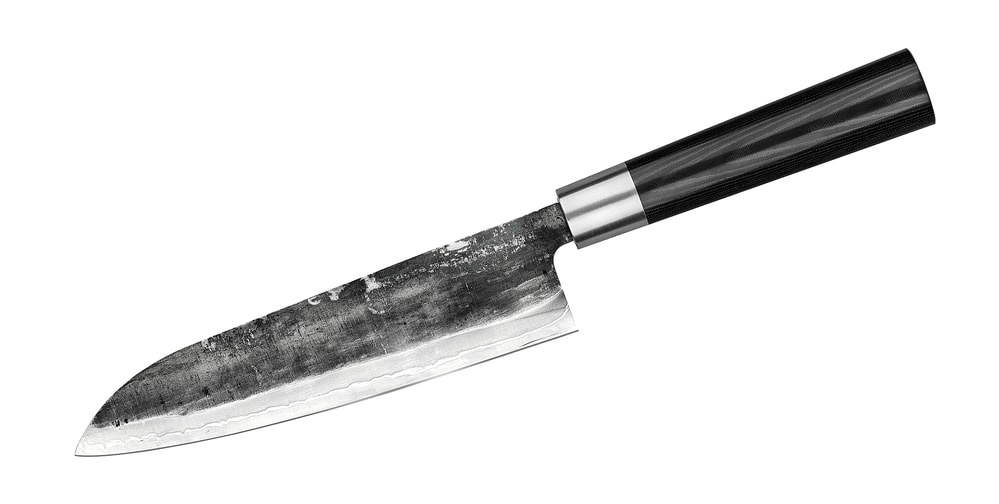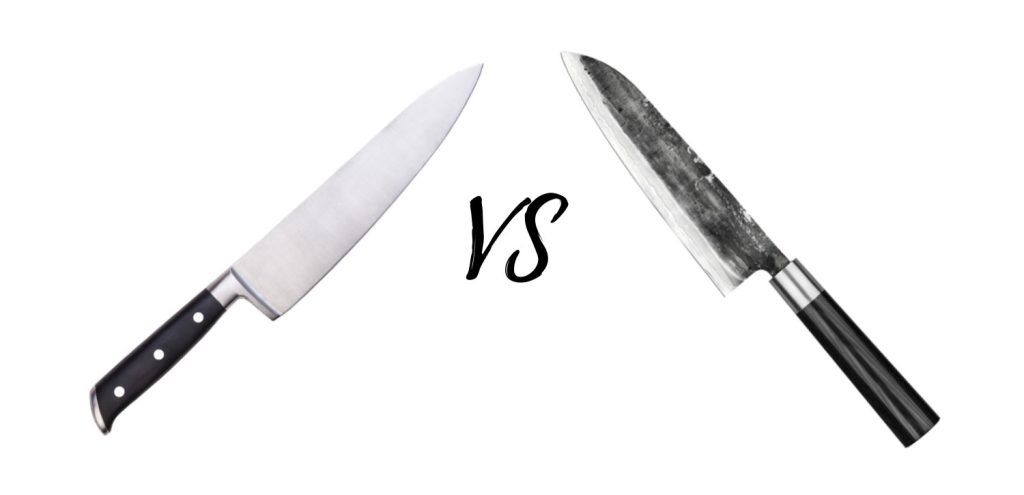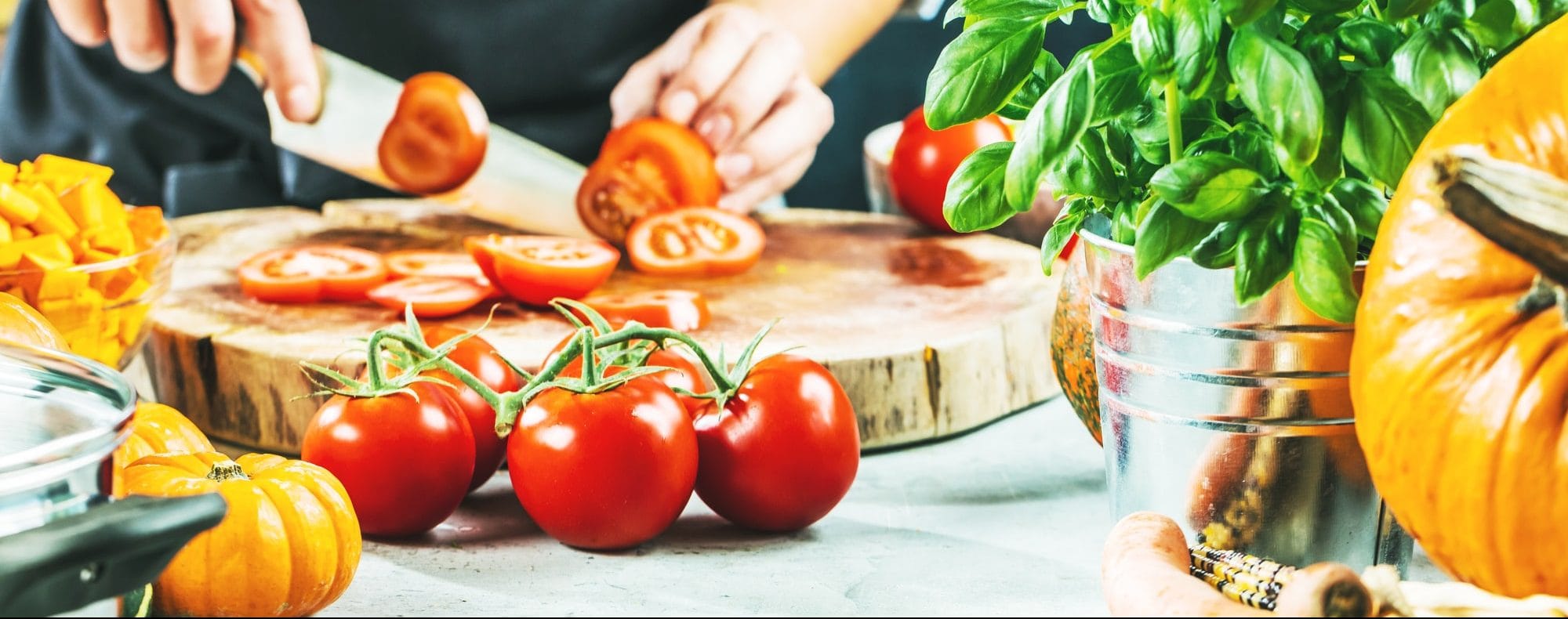A chef is only ever as good as the knives they’re using. If you’re new to the culinary arts and are wondering which tool to use, it’s important to make sure you understand each type of knife that’s out there so you can avoid wasting your money. When it comes to the gyuto VS chef’s knife question, it can be difficult to know which is the right way to go.
On this page, we’ll cover the basics so you can make an informed decision.
Gyuto Chef’s Knife Overview

In short, a gyuto knife is a Japanese knife that’s designed to tackle a broad range of kitchen tasks. It’s a versatile workhorse that can handle most basic kitchen jobs with ease. “Gyuto” means “beef sword” or “beef knife” in Japanese.
This name lends a pretty hefty clue as to the original purpose of these knives – preparing cuts of meat for various Japanese meals. These days, gyuto knives are an excellent alternative to a western chef’s knife and can be used very flexibly in the kitchen.
Gyuto Chef’s Knife Shape
The almost completely flat edge and pointed tip of gyuto chef’s knives make them an excellent tool for most slicing and chopping tasks. Just be aware that you’ll be using an up-and-down chopping motion when using this kind of knife.
If you’re more familiar with the rocking motion that’s used to make fast cuts with most western knives then this may take some getting used to. If you’d like a “happy medium” that can be used in both ways, look for gyuto knives that use the French “sabatier” profile.
Weight
If you’ve never used a gyuto knife before, one of the first things you’ll notice is how lightweight it feels in the hand. The materials and design used for this kind of knife tend to weigh in significantly lighter than your typical chef’s knife.
Gyuto Knife Handle
Another key point of difference when it comes to gyuto VS chef’s knives is their handle. Many models use handles made from either wood or synthetic material and are octagonal or oval in shape.
For some cooks, this can take some getting used to so keep this in mind when shopping.
Gyuto Knife Uses
- Most standard kitchen tasks
- Cutting jobs that call for a lightweight knife
- Dicing, slicing, mincing
- Vegetable prep
Gyuto Knife Basic Stats
- Knife blades are usually between 7 and 12 inches long
- Blade thickness between 1.5 and 5 mm
- HRC of 60 – 63
Chef’s Knife Overview

The weight distribution, size, and shape of most western chef’s knives should be familiar to cooks in Europe and North America. They’re designed to blitz through most general kitchen prep like nobody’s business.
Good quality options feature full-tang, riveted handles with reliable, sharp blades. The learning curve with this kind of knife is relatively low.
Chef’s Knife Shape
Today’s western chef’s knife design emerged from a rich tradition of French and European culinary excellence. The result is a knife that’s great for mincing, julienning, slicing cuts of meat, and much more. You’ll be using a rocking motion to achieve most dices and minces.
This is one point of difference between gyuto and chef’s knives – gyuto knives usually require an up-and-down motion for cuts.
Handle
In contrast to the gyuto’s hexagonal or oval handle, most western chef’s knives employ a more ergonomic design. Most decent chef’s knives use a handle that fits to the contours of the hand snugly.
A riveted, full-tang design is usually your best bet when it comes to durability. Remember that not all chef’s knives are created equal – some handles can leave a lot to be desired.
Weight
Another notable difference when it comes to the gyuto VS chef’s knife question is weight. Western chef’s knives are typically a bit heavier than their Japanese counterparts. This can slow you down when dicing rapidly but can make cutting through denser meats and bones easier.
Chef’s Knife Uses:
- Most standard kitchen tasks
- Meat prep, smaller bones
- Mincing, dicing, slicing
- Prepping vegetables
Chef’s Knife Basic Stats:
- 6 – 12 blade length
- Ideal blade length of 0.25mm
- 57 – 62 HRC
Gyuto VS Chef’s Knife – The Differences
While both western chef’s knives and gyuto knives share a lot of common ground, there are a few key differences to keep in mind.
| Knife | Gyuto | Chef’s Knife |
| Blade Length | 7 – 12 inches | 6-12 inches (usually 6-8, though) |
| Blade Thickness | 1.5 – 5 mm thick | The ideal thickness of 0.25 mm |
| Flexibility | Low | Varies but typically low |
| HRC | 60 – 63 | 57 – 62 |
| Main Purpose | A huge variety of kitchen tasks – a bonus for speed | A huge variety of kitchen tasks – a bonus for denser cuts |
The Handles
Most gyuto knives feature a wooden or faux-wooden handle that’s oval or hexagonal in shape. This can look absolutely gorgeous but may feel uncomfortable for some. Western chef’s knives typically feature more ergonomic handles made from synthetic materials.
Be sure to buy full-tang models wherever possible! It’s also worth noting that some modern gyuto knives also employ a more ergonomic design these days.
The Weight
Gyuto knives are typically lighter than western chef’s knives. Lighter knives are faster to handle but can’t tackle denser meats as easily. Heavier knives are a bit slower but can manage bones and bigger cutting tasks.
How to Choose the Right Option
The headline here is that both gyuto knives and western chef’s knives are incredibly versatile in the right pair of hands. If you’re looking for our advice, the following three statements may help:
- The performance of gyuto VS a chef’s knife is very similar if you’re just doing basic kitchen work.
- Gyuto handles tend to look nicer but be a bit less comfortable than chef’s knives.
- Gyuto knives tend to be a bit lighter than chef’s knives.
Gyuto Recommendation
We’re completely in love with this gyuto knife:
It’s reasonably priced, features a riveted handle, and performs very well.
Find the best gyuto knife.
Chef’s Knife Recommendation
It’s hard to go wrong with this chef’s knife:
– Victorinox Fibrox Pro, 8 Inch Chef’s Knife
It’s the best balance of performance to price we’ve seen in a long while.

Final Thoughts
The main things to worry about here are weight and handle design. Other than these two factors, gyuto knives and chef’s knives are fairly interchangeable when it comes to daily kitchen tasks. Remember that western knives usually require a rocking motion for efficient cuts. Gyuto knives work best with an up-and-down motion.
Just be sure to find a handle design and weight distribution that works for you!




Post Your Thoughts